![]()
- Arrgghh, Thar Be Lobsters Among Us....
- ADA Diveheart Event in Key Largo
- Grenada Recap
- Exclusive Tour to Aquarius Reef Base
- Still Time To Save the Coral Reefs!
- Fantastic Looe Key/Key West Weekend
- In Praise of Photo-Correcting Software
- Algae Blooms
- Mermaids? Here in South Florida?
- Newsletter Delivery Options
- Email or Address Change?
- T-Shirts For Sale
- ADA Guidelines and Policies
Arrgghh,
Thar Be Lobsters Among Us....
--by Dr. Dan Baeza
The annual carnage that is known as lobster season is about to start. This year the season runs from AUgust 6, 2017 to March 31, 2018. There is also a mini 2-day "Sport Fisherman" season falls on July 26th and 27th, per the Florida Fish and Wildlife. During the 8-month regular season, a recreational collector with a valid lobster permit, may possess 6 legally obtained lobsters per day. The lobster must measure at least 3 inches from the eyes to the edge of the carapace. The tail may only be separated on land and measure at least 5-1/2 inches in length. See Lobster Regulations for specific details.
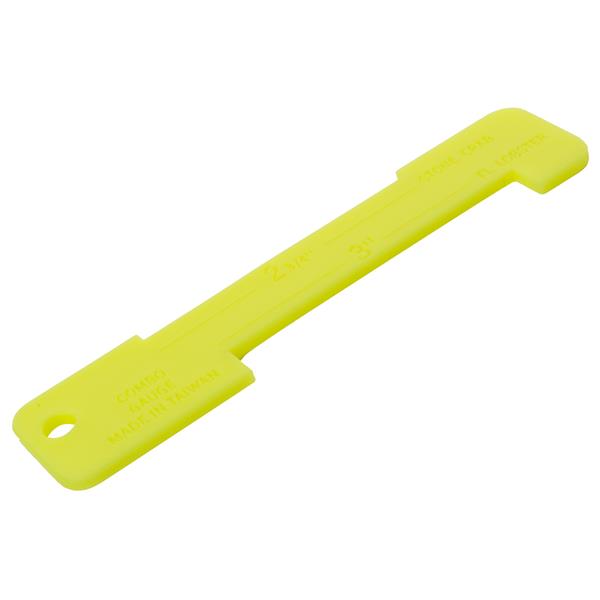
Once you have a grasp of what constitutes a legal catch, you now need to outfit yourself with the latest in lobstering equipment. The absolute first piece of equipment is a lobster gauge, pictured at right. The gauge has a cutout that is exactly 3 inches long. Measuring the carapace underwater is one of those involute rules that we must do. If the gauge slips over the carapace, the lobster is too short and must be set free. The overall length of the tool is 5-1/2 inches long, the minimum size for a lobster tail. If in doubt, check both measurements underwater to ensure you are within the legal limits.
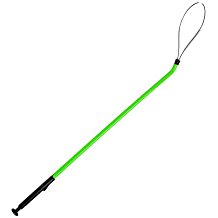 Lobster Snare (Loop)
Lobster Snare (Loop)To catch a lobster, you need patience, cunning, and a tickle stick or lobster snare. Lobsters will generally back into whatever hole they are near if you attempt to approach them from the front. Using a tickle stick to coax them out of the hole works well. A tool I prefer is the lobster snare, pictured at left. Take the snare and carefuly position the loop behind the lobster, slowly moving the loop around its tail. Quickly tighten the loop and the lobster should easily be pulled from the hole.
 Catch Bag with Trap
Door
Catch Bag with Trap
DoorSo, you got it out of the hole. Now what? Well, the next two pieces of equipment are a pair of sturdy gloves and a catch bag. A catch bag with a one-way trap door such as the bag pictured at right works best. Firmly grasp the lobster by the carapace and loosen the loop. Good gloves will minimize the potential for personal injury from the sharp spines covering the lobster's body. The lobster will attempt to escape, so be sure you have a good grip on it. Push the lobster all the way through the trap door. Be sure the bottom of the bag is properly sealed, or all your work will be for naught.
.....And that would make you very sad.....
![]()
ADA
Diveheart-trained Dive Buddies and Instructors
Invited
to Participate in Aug. 19-25 dives in Key Largo
--by Connie Crowther
ADA members who were certified by Diveheart instructors in 2007 and 2008 as buddies and instructors for divers of varied abilities are invited to participate in the August 19-25 Diveheart adaptive diver trip to Key Largo.
The Diveheart dives are hosted by Rainbow Reef in Key Largo, the dive operation ADA also regularly uses for Key Largo dives. Certified buddies and divers must register now for the August dive trip by using this link: http://www.signupgenius.com/go/70a0f4ca4a929a31-august
 ADA was responsible for
originally bringing Diveheart training to South Florida 10
years ago. We offered several Diveheart/Handicapped Scuba
Association courses during 2007-2008. About 30 divers in ADA
at the time received HSA certifications. The first rigorous
course, held in September 2007, culminated in a dive in the
Venetian Pool in Coral Gables with 10 students with various
physical challenges. That original ADA/Diveheart event was
covered on the front page of the Miami Herald Neighbors
and local TV at the time.
ADA was responsible for
originally bringing Diveheart training to South Florida 10
years ago. We offered several Diveheart/Handicapped Scuba
Association courses during 2007-2008. About 30 divers in ADA
at the time received HSA certifications. The first rigorous
course, held in September 2007, culminated in a dive in the
Venetian Pool in Coral Gables with 10 students with various
physical challenges. That original ADA/Diveheart event was
covered on the front page of the Miami Herald Neighbors
and local TV at the time.
Rainbow Reef offers a full range of Diveheart adaptive diver training programs and many of their staff are trained to work with adaptive divers. They currently offer Diveheart-developed courses for adaptive diver, adaptive buddy, advanced adaptive buddy and adaptive instructor. Anyone interested in completing the online course and then doing the diving portion of the training with Rainbow Reef before the late August trip can sign up now. For information about training, contact Chris Adams at Rainbow Reef Dive Center at 866-KEYS-IDC or email chris@KeysIDC.com. For further information about other Diveheart adaptive diver certification courses, go to http://www.diveheart.org/training/get-started
The Diveheart trips are open to divers of all abilities. Adaptive divers will have the opportunity to dive with Diveheart-trained buddies. All divers are responsible for their own travel, gear, tips, food and accommodations. Itineraries will be sent out two weeks before the trip. Space is very limited for both adaptive divers and trained buddies and instructors, so early registration is suggested.
For more information about the Diveheart experience, call Connie Crowther, South Florida Diveheart Ambassador, at connie_crowther@msn.com.
![]()
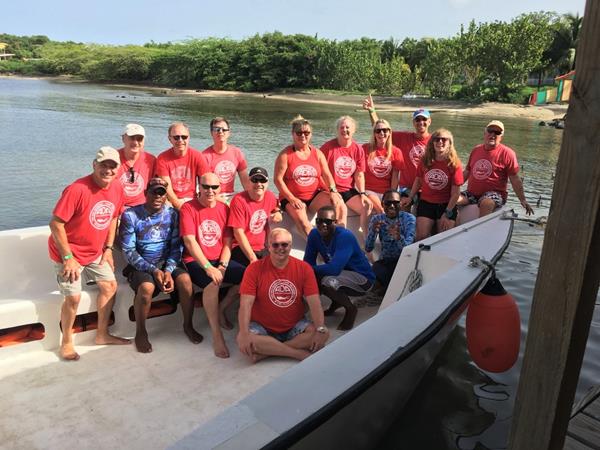 Thirteen lucky divers
just completed an amazing ADA trip to Grenada from July 8 to
13, 2017. Situated in the southeastern Caribbean Sea
northeast of Venezuela, it is an island country consisting
of seven islands. It has not been widely recognized as a
dive destination but the country is working to develop a
more robust tourism industry with a focus on water sports.
Thirteen lucky divers
just completed an amazing ADA trip to Grenada from July 8 to
13, 2017. Situated in the southeastern Caribbean Sea
northeast of Venezuela, it is an island country consisting
of seven islands. It has not been widely recognized as a
dive destination but the country is working to develop a
more robust tourism industry with a focus on water sports.
We stayed at True Blue Bay Boutique hotel which is a beautiful, very Caribbean style resort consisting of about four different style buildings. Our group had rooms in just about every one of the sections and all were very pleased with the accommodations. All of the dining options were open air venues on the water with a delightful breeze. The staff was friendly and dedicated to making sure our visit exceeded our expectations.
 The dive shop was
conveniently located just a short distance from our rooms,
and they also worked very hard to make sure our diving was
as effortless as possible. Once our gear was set up on the
boat they took care of storing and rinsing it daily so all
we had to do was show up ready to dive. We had a boat
dedicated to us throughout the week so there was plenty of
room and we were able to stay together as a group. Our crew
consisted of Chris, Larry and, Myron, who alternated as boat
captain and divemasters throughout the trip and were very
experienced and helpful.
The dive shop was
conveniently located just a short distance from our rooms,
and they also worked very hard to make sure our diving was
as effortless as possible. Once our gear was set up on the
boat they took care of storing and rinsing it daily so all
we had to do was show up ready to dive. We had a boat
dedicated to us throughout the week so there was plenty of
room and we were able to stay together as a group. Our crew
consisted of Chris, Larry and, Myron, who alternated as boat
captain and divemasters throughout the trip and were very
experienced and helpful.
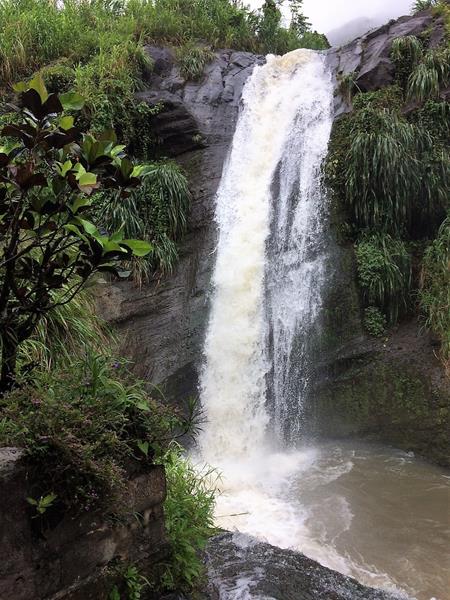 Our package included
two morning dives each day from Sunday through Thursday,
with optional afternoon and night dives. Our winners of the
“Ironman” diver award were Rachel and John, who logged 15
total dives! The dives consisted of a variety of wreck and
reef drift dives as well as a special visit to the marine
park. Widely seen on magazine covers is an underwater
sculpture of children holding hands which is among several
other sculptures placed throughout the park. The reefs and
marine life were all healthy and at depths anywhere from 40
to 100 feet. Our biggest disappointment was a layer of
“green” water that had been swept up from heavy rains in
Venezuela which diminished slightly throughout the week. We
were lucky to be there that week with good weather, as
Tropical Storm Don was approaching as we left.
Our package included
two morning dives each day from Sunday through Thursday,
with optional afternoon and night dives. Our winners of the
“Ironman” diver award were Rachel and John, who logged 15
total dives! The dives consisted of a variety of wreck and
reef drift dives as well as a special visit to the marine
park. Widely seen on magazine covers is an underwater
sculpture of children holding hands which is among several
other sculptures placed throughout the park. The reefs and
marine life were all healthy and at depths anywhere from 40
to 100 feet. Our biggest disappointment was a layer of
“green” water that had been swept up from heavy rains in
Venezuela which diminished slightly throughout the week. We
were lucky to be there that week with good weather, as
Tropical Storm Don was approaching as we left.
On Friday we all went on a tour of the island with Edwin Frank, a very experienced and entertaining guide and driver. We spent 10 hours seeing waterfalls, a spice plantation, chocolate factory, rum distillery, the old city of St Georges and too many other sites to describe here.
And then it was time to pack and get ready for our flights the next day- and to ask which island paradise would be the next destination for an awesome ADA dive trip !!
Registration is now open! >>Click here to register <<
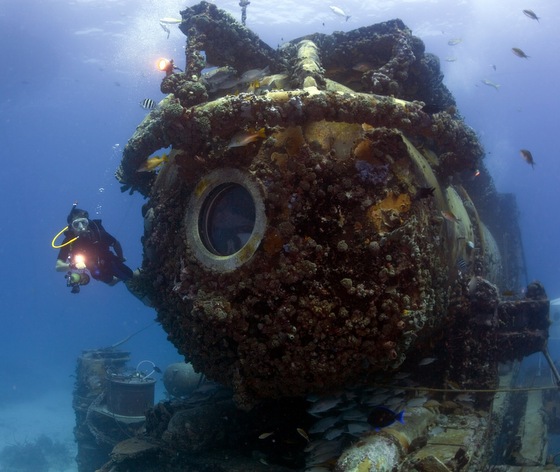 ADA is partnering with
Florida International University's Aquarius Reef Base for the unique
opportunity to dive down and tour the Aquarius Base. The
Aquarius Experience guest dives were developed to provide a
once-in-a-lifetime opportunity for non-professional divers
to make a dive to Aquarius. Less than 1,200 divers have ever
had the opportunity to enter Aquarius.
ADA is partnering with
Florida International University's Aquarius Reef Base for the unique
opportunity to dive down and tour the Aquarius Base. The
Aquarius Experience guest dives were developed to provide a
once-in-a-lifetime opportunity for non-professional divers
to make a dive to Aquarius. Less than 1,200 divers have ever
had the opportunity to enter Aquarius.
 The mission at Aquarius is
to conduct marine ecosystem science, test bed novel marine
technologies, train professional divers for extreme
environment operations and develop formal experiential
education programs. Aquarius is located in a research-only
area within the Florida Keys National Marine Sanctuary, and
access to the area is tightly controlled and mission
protocols for dive operations are rigorous out of necessity.
The mission at Aquarius is
to conduct marine ecosystem science, test bed novel marine
technologies, train professional divers for extreme
environment operations and develop formal experiential
education programs. Aquarius is located in a research-only
area within the Florida Keys National Marine Sanctuary, and
access to the area is tightly controlled and mission
protocols for dive operations are rigorous out of necessity.
We are offering six lucky ADA divers the Aquarius
Experience opportunity on Sunday, August 20th for $500 per
person. The cost covers a full day (8am to 5pm) including
introductory program overview of Aquarius operations and
scientific research, two dives to Aquarius including a tour
of the inside guided by scientists, plus a box lunch.
SPACE IS VERY LIMITED SO RESERVE YOUR SPOT
TODAY!
This program has been added to the 2017 Dive Schedule. >>Register and make your payment here <<
NOTE: Due to our contract with the providing agency, no refunds are possible unless the project is cancelled due to weather. In that case, full refunds less a small service charge, will be issued.
![]()
Still Time To Save the Coral Reefs!!
>> UPDATED!! <<
Receive a Free One-Year Membership
Although there is still room to reserve your spot on ADA’s
November 5th
full-day Coral Restoration Foundation (“CRF”) program, act
now to book the dive and add a whole new perspective to
Florida Keys diving. Thanks to CRF and the work of
volunteers, including dozens of ADA members over the last
ten years, the reefs are coming back to more of the
spectacular beauty they had decades ago, before contaminated
waters, ship groundings, and extreme weather events started
taking their toll.

Now when I dive the reefs where I and dozens of other ADA members started transplanting baby corals back in 2007, it is amazing to see healthy staghorn branches stretching up more than three or four feet tall. We really have made a difference that we can see for ourselves! With your continued help during this year’s CRF trip, generations to come will enjoy spectacular beauty instead of a bleached-out decimated reef system.
 Don’t know anything about
marine science and coral transplanting techniques? Not to
worry; CRF trains every diver in morning lecture and
hands-on sessions in its state-of-the-art facility, where
we will learn the latest techniques for cutting
and prepping baby corals for outplanting; transplanting them
onto the reefs; maintaining previously-planted coral
gardens; and documenting the successes of our efforts. Then
after a lunch break, we will board a boat specially reserved
only for our ADA/CRF program, for a two-tank dive. Our first
dive will be a tour of the coral nursery, and involve
setting-up for our outplanting tasks. Then we will move to
the reef and perform outplanting and maintenance activities
on the corals.
Don’t know anything about
marine science and coral transplanting techniques? Not to
worry; CRF trains every diver in morning lecture and
hands-on sessions in its state-of-the-art facility, where
we will learn the latest techniques for cutting
and prepping baby corals for outplanting; transplanting them
onto the reefs; maintaining previously-planted coral
gardens; and documenting the successes of our efforts. Then
after a lunch break, we will board a boat specially reserved
only for our ADA/CRF program, for a two-tank dive. Our first
dive will be a tour of the coral nursery, and involve
setting-up for our outplanting tasks. Then we will move to
the reef and perform outplanting and maintenance activities
on the corals.
The cost of the program is $130 for the full day, including classroom instruction, boat trip, tanks, weights, diving, and lunch. For an additional charge you can receive your PADI Coral Restoration Specialist Certification and accompanying PADI Certification Card.
CURRENT MEMBERS WILL RECEIVE A FREE ONE YEAR MEMBERSHIP EXTENSION ( TO DEC. 31, 2018), and NEW MEMBERS WILL RECEIVE A FREE MEMBERSHIP (to Dec. 31, 2018).
The cost is well worth it. You will for years in the future remember the important work you are doing, when you visit the reefs you replanted and see the results of your efforts. Click here to book this dive.
A Youtube video showing ADA divers at work on a past CRF project (mine is the bald head)can be seen by clicking here.
Call me at (305) 519-8897 or send me an email with any questions about this year’s CRF program. My email address is roy@wassonandassociates.com. I hope to plant some coral with you next month.
![]()
--by Rachel Davis
 On July 22 and 23, ADA
divers set out for Looe Key and Key West for an
adventuresome weekend of diving and enjoying the sights. The
morning of Saturday, July 22nd, three ADA divers toured the
Turtle Hospital in Marathon. The Turtle Hospital rescues,
rehabilitates and releases injured sea turtles. The tour was
very informative and we really enjoyed it.
On July 22 and 23, ADA
divers set out for Looe Key and Key West for an
adventuresome weekend of diving and enjoying the sights. The
morning of Saturday, July 22nd, three ADA divers toured the
Turtle Hospital in Marathon. The Turtle Hospital rescues,
rehabilitates and releases injured sea turtles. The tour was
very informative and we really enjoyed it.
The next chapter of our adventure brought us to Looe Key resort where we boarded a very large, crowded pontoon boat, with 16 divers and 30 snorkelers. On the way out to the Looe Key National Marine Sanctuary, we ran into a large pod of friendly dolphins. Captain Katie pulled alongside so we could get a closer look at them frolicking in the aqua blue water. It's always a good omen to run into dolphins in a dive trip and this pod portended two wonderful dives in crystal clear, warm water.
The towering finger reefs of Looe Key were teeming with life: tropicals of all kinds including, schooling Atlantic Spadefish, two free-swimming Caribbean reef sharks, and pristine examples of pillar and elkhorn coral. At the end of the second dive, we were treated to a visit by "Junior" the resident Goliath Grouper, who was getting friendly with the divers and snorkelers under the boat.
 After a relaxing afternoon
at Looe Key's pool and dinner at the Tiki bar with live rock
and roll music, Sunday morning came bright and early. We
made our way down to Key West for the 7:30 a.m. check-in at
Lost Reef Adventures to experience one of south Florida's
best wrecks - the General Hoyt S. Vandenburg. Once a
military transport ship, it was converted to a satellite
tracking vessel that once tracked space launches off of Cape
Canaveral, complete with swim-through satellite dishes,
whose aluminum is unfortunately disintegrating after years
of exposure to salt water. We moored to Ball #4, which was
2two-thirds of the way to the stern. There was a mild
current on the first dive, but it became stronger as the
second dive progressed. Still is was possible to cover the
entire length of the 524 foot vessel between both dives. The
ship had good coral encrustation, numerous large barracudas,
schooling Bermuda chubs, crevalle jack, and schooling brown
chromis. There was a significant thermocline at 75 feet with
water temp 87 above and 82 degrees below. With the current
getting stronger, the crawl to the bow into the current was
a workout but the free ride back two-thirds of the length of
the ship was exhilarating. Interesting rooms to explore such
as the cut-out navigation bridge. The dive was over by
noontime, which left plenty of time to take in the sights of
Key West before heading home.
After a relaxing afternoon
at Looe Key's pool and dinner at the Tiki bar with live rock
and roll music, Sunday morning came bright and early. We
made our way down to Key West for the 7:30 a.m. check-in at
Lost Reef Adventures to experience one of south Florida's
best wrecks - the General Hoyt S. Vandenburg. Once a
military transport ship, it was converted to a satellite
tracking vessel that once tracked space launches off of Cape
Canaveral, complete with swim-through satellite dishes,
whose aluminum is unfortunately disintegrating after years
of exposure to salt water. We moored to Ball #4, which was
2two-thirds of the way to the stern. There was a mild
current on the first dive, but it became stronger as the
second dive progressed. Still is was possible to cover the
entire length of the 524 foot vessel between both dives. The
ship had good coral encrustation, numerous large barracudas,
schooling Bermuda chubs, crevalle jack, and schooling brown
chromis. There was a significant thermocline at 75 feet with
water temp 87 above and 82 degrees below. With the current
getting stronger, the crawl to the bow into the current was
a workout but the free ride back two-thirds of the length of
the ship was exhilarating. Interesting rooms to explore such
as the cut-out navigation bridge. The dive was over by
noontime, which left plenty of time to take in the sights of
Key West before heading home.
The ADA Key West weekend is in its third year and, due to popular demand, Lon promised to put it back on the ADA dive schedule for 2018.
![]()
We dream as divers, of 100-foot visibility, bright sunny days, and shallow reefs teeming with fish life. Alas, we often have to make do with far, far less. As photographers, we have to bring artificial light down with us, attach brightness-dulling filters, and deal with creatures that are less interested in posing, and more interested in snatching a meal, while not becoming one themselves. Every once in a while, Mother Nature hands us an additional curve in the way of algae bloom, turning the top layer of water green, and killing most of the ambient light, already in short supply, to a mere fraction.
The incessant rains the week prior to ADA's recent trip to Grenada featured such conditions as green water and limited light. To make matters worse, I did not have a magenta filter with me to counteract the taxing conditions. So, even with a strobe and electronic filtering within my camera's setup, my photos took on an emerald hue. Unfortunately, your brain "knows" what color you should be seeing and corrects it on the fly. Not so with a camera. It just records what it sees and apparently, our internal filters work better than the camera's.
After the first day's shooting, I reviewed my photos. Ugh! Every single one of them looked like a Saint Patrick's Day parade gone sour. (See photos displayed after the "Continue reading" button).
![]()
Do they affect the diving in South Florida? Are you serious? Of course, they do. Last year, Peanut Island was closed off due to a bloom on July 4th. Incredibly, Phil Foster Park right next to it was not closed. Tell me that was not about disturbing the holiday. If you have been there you know they are both in the same waters. Phil Foster Park in where you dive the Riviera Beach Bridge, and if you looked out at the island, that is Peanut Island.
Are algae blooms toxic? You bet, that is why they close off the areas. It is toxic cyanobacteria. I’ll let an expert explain that one. (Click here to see Wikipedia’s article on cyanobacteria
Scuba and snorkeling contribute approximately $11 billion to the U.S. GDP. Of course, a lot of this is in Florida. Approximately 4.25 million visitors per year are involved in snorkeling and another 4.6 million for scuba. Where money is concerned there will be actions requested.
This equates to approximately $904 million to the Florida economy each year. Adding in the new divers, an additional $20 million in sales and equipment is added to the local economies. This also includes travel.
So, what is being done? DEMA has asked the Governor to take action to address the problem. We’ll reserve judgement until we see results….
![]()
Have you noticed how hard they are to find? Have you ever seen one? A good looking one? I have. It was right off Singer Island in Palm Beach County.

Hard to believe? Yep, but I know what I saw. Of course it was the latest in dive attractions for the county. It was right in the middle of Andrea’s Reef. It is 20 by 15 feet and is 75 feet of water. It weighs 60,000 puunds. This is located about one mile north of the Lake Worth inlet east of Ocean Reef Park.
We can thank artist Thomas McDonald for the design it with some help from students from the Riviera Beach Maritime Academy. This reef also has additional attractions: Roman columns, a treasure chest, sea turtles and sting rays.
For more information, go to rbmaritime.org. It was named and sculpted after three time breast cancer survivor Andrea Torrente. If you plan on diving this site bring your camera as it it is popular with photographers.
![]()
 Juvenile Stotted
Drum photographed
Juvenile Stotted
Drum photographedin Grenada by Dan Baeza
![]()
If so, please email or call us with your current information. You may send an email to: Dr. Dan Baeza, Membership Chair at ActiveDiversInfo@gmail.com. You can also call Dan at 954-260-8225 and leave a message with your new contact information.
Show your pride in the best dive club anywhere! Sizes small, medium, large, xlarge, xxlarge. Some tank tops available also. All shirts are $10 each. CALL LON AT 305-251-4975 AND PLACE YOUR ORDER TODAY!. Lon will deliver it to you on your next dive

 Butteryflyfish
photographed
Butteryflyfish
photographedin Grenada by Dan Baeza
![]()
Want your newsletter delivered via snail-mail? Contact the webmaster and request a printed copy.
Be sure to put "ADA Newsletter" in the subject.



